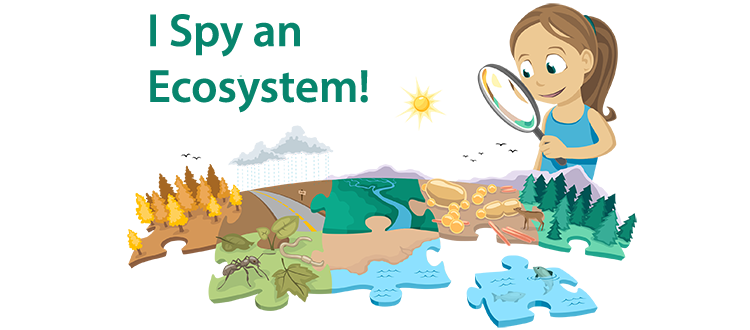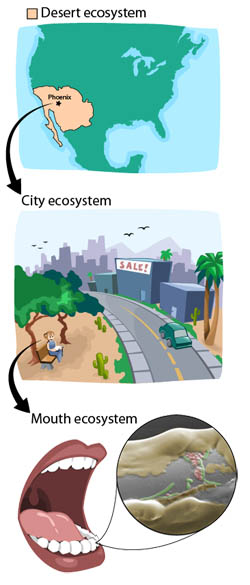
Illustrated by: Sabine Deviche
show/hide words to know
Abiotic: non-living things....more
Biotic: living things.
Decomposers: living things that feed on and break down things that are dead.
Percolate: the process of filtering a liquid or gas slowly through a porous material or a material with small holes (filter). Coffee is made by percolating water through a filter holding coffee bean grounds.
Resilience: ability to return to previous conditions after sudden changes.
Scale: is used to describe the size differences between objects, or how large or small an object is.
What Is an Ecosystem?
We hear the word ecosystems in the news and at school but just what are ecosystems? To start off, let's take a quick look at the word because it holds some clues to its meaning. "Eco" comes from ancient Greek and Latin and means "house". So "eco" means that all of the parts exist together, as if they were together in a house. You have probably heard the word "system" in lots of places, and it means "interacting parts". So "system" tells us that not only do the parts exist together as if they were in one house, but the parts also affect one another.
Think of the last time you were outdoors. You were probably outside your house or your school. What did you see? You maybe saw living things like grass and people. You may also remember non-living things like concrete, soil, or maybe puddles or snowbanks. An ecosystem contains all of those parts that you can see, like soil, water, insects, rocks, birds, trees, and people. There are also parts you cannot see with your eye, including microscopic organisms like bacteria and fungi, or molecules of food and nutrients that are in water, soil, and air.
Often, ecosystems are confused with another word- habitat. This describes the conditions a particular organism needs to live. For example, a whale needs salty water and fish to eat, gophers need plants to eat and soil to burrow in, and giant sequoias (a tree) need lots of water and soil nutrients. Ecosystems include much more than just the requirements needed for a particular type of organism to live. Ecosystems include interactions among many types of organisms and abiotic parts of the environment too.
Where Are Ecosystems?

Now that you know what an ecosystem is, you might think you have a good idea where you would find one. But you might be surprised by all the places where you can find an ecosystem. Did you know that your mouth holds an ecosystem? Yes, rub your tongue over your teeth when you get up in the morning. Notice the slimy coating? That coating is part of a developing ecosystem. Your mouth has many types of microscopic organisms living in it, including bacteria, fungi, and protozoa. These organisms get the food and nutrients they need to live from the foods you eat. The types of foods you eat allow some organisms to grow better than others. Your teeth are surfaces that the microorganisms can hold on to as they grow and reproduce, but the microorganisms also make acid that can change the structure of your teeth (giving you cavities).
After you brush your teeth and head off to school or work, you find yourself within an ecosystem that may be a town or city. Or maybe you live in a forest or a farm. In fact you are part of the ecosystem. You are part of an ecosystem because you interact with the other parts of the ecosystem. You eat other organisms and your waste products in turn may be used by still other organisms for their growth. You also breathe air and drink water that is present in your ecosystem, and by doing this, you change the makeup of the air and water. Ecosystems are not defined by their scale, but can be any size. If you look around you will begin to see many examples of ecosystems. Ponds, lakes, coral reefs, streams, or the whole ocean are just a few examples. And you can see that size is not part of the definition of an ecosystem.
How Do Ecosystems Work and What Do They Do?
Now that we know that ecosystems are all around us, let's try to figure out what exactly ecosystems do. Since we know that ecosystems are made up of many interacting abiotic and biotic parts, those interactions must hold the key to what ecosystems can do. First, an ecosystem needs energy to work. Just like the computer you are using to read this, an ecosystem cannot function without energy. In many ecosystems, energy first enters the ecosystem from the sun. You may have heard of solar-powered electricity. Well, many ecosystems are also solar-powered. Plants and some bacteria can capture energy from sunlight and store it in their tissues. They use the energy to grow and reproduce.
The energy captured by plants doesn't stay there forever. Plants are food for consumers, so the energy in plant tissues is passed on to organisms that eat plants. Predators get their energy by eating consumers. Dead plants and animals are food for tiny micro-organisms like bacteria and fungi. You probably know these feeding relationships as a food web. The food web allows energy to flow through the ecosystem and power the activities of many organisms (including people).

Ecosystems include things you can see, like water, soil, and vegetation. They also include things that are hidden from our eyes, like organisms living underground and micro-organisms that are too small to see with our eyes. Ecosystems include not only living and non-living things, but also interactions among them. In this forest ecosystem, precipitation, represented by blue arrows, may be taken up by plants by roots, or may percolate through the soil and be stored as groundwater. Sunlight, shown in yellow, provides energy to plants. This energy may be passed on to animals that eat plants (shown by the green arrow), like the deer in this forest. The energy in plants may also be passed to decomposers (brown arrows), like earthworms and bacteria that live in dead plant material or soils. Micro-organisms that are attached to plant roots may help plants to capture some of the nutrients that are released as decomposers break down dead materials. (photo credit: Paula Flynn, Iowa State University Extension)
If you have ever taken vitamins, been told to eat your vegetables, or sipped an energy drink, you know that food contains more than just energy. Organisms get essential nutrients like nitrogen and phosphorus from their food in addition to energy. Nutrients cycle through the abiotic and biotic parts of ecosystems and are passed between organisms in a food web. Nutrients may also be converted in forms, move around the ecosystem in water or wind, or may leave the ecosystem entirely. Follow the salmon below to catch up with what happens to nutrients once they leave the ecosystem.
You may have heard that ecosystems are delicate and that they can change with only the slightest outside influence. Ecosystems are always changing, so it is true that ecosystems rarely stay the same for long periods of time. But ecosystems are far from delicate. Sometimes changes in ecosystems are slow and gradual, like a forest growing from a group of seedlings to mature old trees. Other times changes happen suddenly. Fires, floods, or volcano eruptions can quickly remove most of the biotic parts from an ecosystem and can even change the abiotic parts.

Now that you know what an ecosystem is just how are ecosystems related?
Often ecosystems can bounce back from these big changes and return to the way they were before the sudden event. We use the word resilience to describe the ability to bounce back from a change in conditions. However, there are changes to ecosystems that are so large that ecosystems cannot bounce back. Climate warming and inputs of fertilizers from agriculture are examples of forces that ecosystems often do not bounce back from.
Additional images from Wikimedia. Human mouth image by Ανώνυμος Βικιπαιδιστής.
View Citation
Bibliographic details:
- Article: I Spy an Ecosystem
- Author(s): Tamara Harms
- Publisher: Arizona State University School of Life Sciences Ask A Biologist
- Site name: ASU - Ask A Biologist
- Date published: September 22, 2009
- Date accessed: April 17, 2024
- Link: https://askabiologist.asu.edu/explore/i-spy-ecosystem
APA Style
Tamara Harms . (2009, September 22). I Spy an Ecosystem. ASU - Ask A Biologist. Retrieved April 17, 2024 from https://askabiologist.asu.edu/explore/i-spy-ecosystem
Chicago Manual of Style
Tamara Harms . "I Spy an Ecosystem". ASU - Ask A Biologist. 22 September, 2009. https://askabiologist.asu.edu/explore/i-spy-ecosystem
Tamara Harms . "I Spy an Ecosystem". ASU - Ask A Biologist. 22 Sep 2009. ASU - Ask A Biologist, Web. 17 Apr 2024. https://askabiologist.asu.edu/explore/i-spy-ecosystem
MLA 2017 Style

You may not know it, but your mouth is home to one of many ecosystems.
Be Part of
Ask A Biologist
By volunteering, or simply sending us feedback on the site. Scientists, teachers, writers, illustrators, and translators are all important to the program. If you are interested in helping with the website we have a Volunteers page to get the process started.








